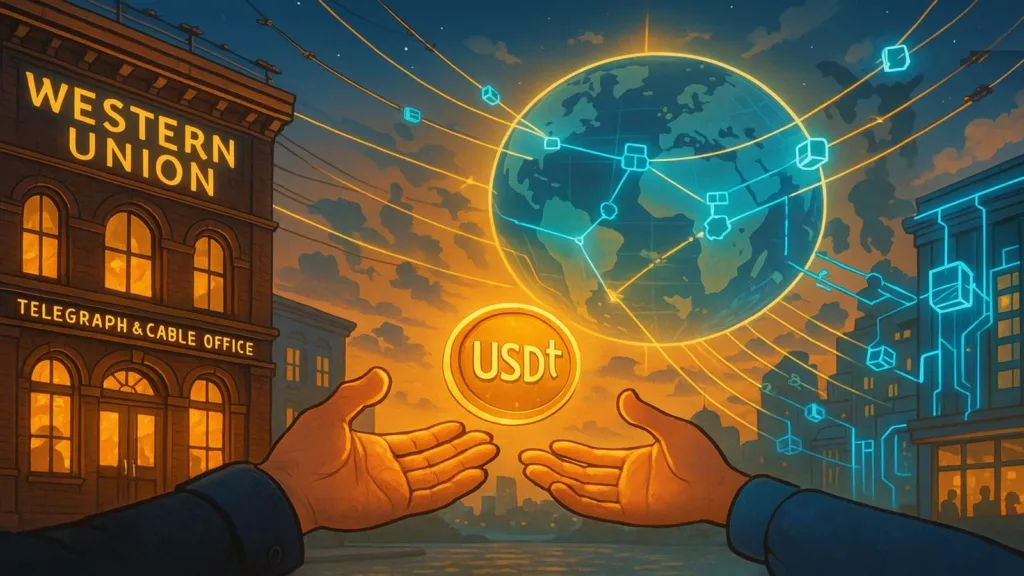The world’s oldest remittance giant is stepping into the blockchain age, and this time, it might actually change how everyday people move money.
There are moments in finance when history takes a quiet but irreversible turn. The news that Western Union is to issue a dollar-pegged stablecoin is one of those moments. For most people, Western Union means yellow storefronts, long forms, and the familiar ritual of sending money home. But now, the company that once connected the world with telegraph wires is trying to connect it with blockchain.
In simple terms, Western Union plans to launch its own digital dollar, a U.S.-backed stablecoin called the U.S. Dollar Payment Token (USDPT). Built on the Solana network and backed by reserves at Anchorage Digital Bank, it will let people send money across borders in seconds instead of days. And yes, it will work hand in hand with Western Union’s 400,000 outlets worldwide.
That’s not just a tech upgrade; that’s a full-scale evolution of a 170-year-old brand.
From Telegrams to tokens
If you grew up seeing your parents queue up to wire money, you’ll understand how radical this shift feels. Western Union was born in the age of Morse code; it sent the first telegram in 1861. A century later, it dominated global money transfers. Now, in a world obsessed with blockchain, the company’s leadership seems to have realized that speed and trust are the only currencies that matter.
By choosing Solana, a blockchain known for speed and low fees, Western Union is making a statement: this isn’t just about joining the crypto bandwagon. It’s about reinventing remittances. Every year, migrant workers send over $860 billion globally. Much of that money still flows through high-fee, slow systems. A stablecoin built directly into a remittance network could slash those costs overnight.

The difference between talk and transformation
Let’s be honest, this isn’t the first time a financial giant has flirted with crypto. PayPal rolled out its own PYUSD stablecoin last year. MoneyGram tested cross-border transfers using USDC. Even Visa and JPMorgan have quietly built blockchain settlement layers. But none of them has the global physical reach that Western Union commands.
Imagine this: a user in rural Nigeria or the Philippines walks into a Western Union shop, buys a few dollars’ worth of this stablecoin, sends it across the world in seconds, and the receiver cashes it out locally. No bank account. No middlemen. Just instant value transfer. That’s not theoretical; that’s what Western Union issuing a dollar-pegged stablecoin could make real.
Why the Western Union plans matter
Stablecoins today move nearly $150 billion in daily volume. They’re already the quiet backbone of global crypto trading, but they haven’t broken into mainstream remittance markets. Western Union’s entry changes that math. The company isn’t just tokenizing dollars; it’s tokenizing trust.
Of course, this isn’t without hurdles. Regulators are watching stablecoins like hawks. Questions about reserve transparency, compliance, and anti-money-laundering checks will define whether this grand experiment succeeds. But if anyone knows how to navigate regulation across continents, it’s Western Union.
Here’s the irony: a firm that once relied on telegrams could soon be the one teaching the next generation how to move money digitally. In many ways, this is the perfect full circle: old-money infrastructure meeting new-world technology.
It’s also a reminder that innovation doesn’t always come from startups. Sometimes, it comes from survivors, companies that reinvent themselves just when the world assumes they’re relics.
Key takeaway
Western Union issuing a dollar-pegged stablecoin might sound like another corporate crypto experiment. But it’s far bigger than that. It’s a glimpse into a world where sending money feels as easy as sending a text, only safer, faster, and cheaper.
If Western Union gets it right, this won’t just be another blockchain story. It’ll be the rebirth of a financial giant that helped connect the world once and might do it again, this time through code.








